#Brazil's National Museum
Explore tagged Tumblr posts
Text

The Bendegó Meteorite in the National Museum, Rio de Janeiro, Brazil
Brazilian vintage postcard
#bendeg#sepia#rio de janeiro#photography#vintage#postkaart#museum#brazilian#meteorite#janeiro#ansichtskarte#ephemera#carte postale#postcard#postal#national#briefkaart#photo#the national museum#brazil#tarjeta#historic#postkarte
11 notes
·
View notes
Text

13 September 2024






#Denmark#Brazil#President Luiz Lula da Silva#Sonia Guajajara#Tupinamba cloak#sacred cloak#Rio de Janeiro#scarlet ibis bird#Tupinamba#indigenous people#artefacts#history#culture#museum#Nationalmuseet#National Museum#ceremonial cape
5 notes
·
View notes
Text
I was trying to find out how a museum in Parma ended up with (apparently) 500 Kayapò pieces in their collection and ran into this article instead... gave me some hope for Brazilian museums and museums in general, at least.
This part was heartbreaking however:
Over the past few years, multiple Guarani-Kaiowá prayer houses — large, thatched structures used for religious events, festivities and community meetings — have been set on fire in Mato Grosso do Sul. In 2018, when Benites told Guarani-Kaiowá communities about the National Museum fire, they expressed sympathy rather than anger. They assumed the fire had been deliberately set by people who wanted to destroy the Indigenous artifacts housed within. “For the Guarani-Kaiowá, somebody got there, didn’t like what they saw and set the place on fire,” Benites says. “Because this is what it’s like here.”
4 notes
·
View notes
Text
‘Magical moment’ as fire-ravaged Brazil museum receives big fossil donation
Collection of more than 1,000 fossils including rare dinosaurs given to National Museum in Rio six years after devastating blaze

Nearly six years after it was engulfed by a devastating fire that inflicted incalculable damage on Brazil’s cultural heritage, the country’s national museum has received an important donation of more than a thousand fossils as part of a campaign to help rebuild the collection lost to the flames.
The fire, caused by an electrical short-circuit on the night of 2 September 2018, consumed the former imperial palace which housed the 200-year-old museum in a park just north of Rio de Janeiro’s city centre and destroyed about 85% of its archive of 20m artefacts.
Losses included Egyptian and Greco-Roman relics acquired by the Brazilian imperial family, a large dinosaur named Dinoprata, and invaluable records of Indigenous life and culture in pre-colonial times.
Efforts are now under way to rebuild the collection ahead of the museum’s planned reopening in April 2026. Reconstruction works on St Christopher’s Palace began in 2021. The restored facade and front courtyard were unveiled a year later, but works continue on the rest of the building.
Continue reading.
#brazil#brazilian politics#politics#national museum of brazil#science#biology#paleontology#mod nise da silveira#image description in alt
4 notes
·
View notes
Text
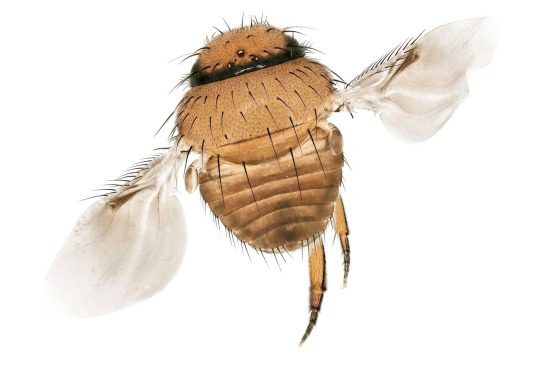
Trapped at eight meters (26 feet) above the ground, this yet-to-be-named phorid fly species is a “parasitoid death-dealing machine” that jabs its eggs into other insects, says entomologist Brian Brown. Brown, the curator of entomology at the Natural History Museum of Los Angeles County, photographed the insects in this article using a camera-and-microscope setup that was originally developed to examine flaws in computer chips. Photograph By Brian Brown, Natural History Museum of Los Aangele County
For Insects, The Amazon’s Canopy Contains A Dazzling Multiverse
A new study finds that high in rainforest trees, insects live in ecosystems that vary wildly from the forest floor on up.
— By Natasha Daly | Published March 2, 2022 | Saturday October 7, 2023
“I thought, my God, this is like someone’s discovered another continent!” says Brian Brown, an Entomology Curator at the Natural History Museum of Los Angeles County. He was talking about insects.
When studying insects in the Amazon, most entomologists cast their eyes down, to the intricate pathways of moss and underbrush that make up the rainforest floor. But José Albertino Rafael wanted to look up. Really far up—to more than 105 feet in the canopy.
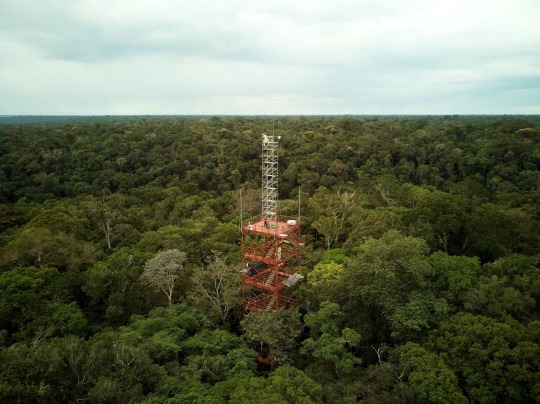
Two hours northwest of Manaus, Brazil, a 131-foot steel tower rises from a pristine area of the rainforest. Built in 1979, the tower had long been used to track the exchange of carbon dioxide between the trees and the atmosphere, but more recently it has been used for pioneering entomology research. Photograph By Craig Cutler
During two weeks in 2017, Rafael, an Entomologist at Brazil’s National Institute of Amazonian Research, and colleagues trapped insects at various heights, starting at ground level, from a 131-foot tower erected in the middle of the Amazon, just outside Manaus.
The findings were staggering, says Brown, who was part of a team that examined and recorded all 37,000 insects that were collected. Nearly half of them were flies. “There were weird and different things. I didn’t even know what genus these were, let alone species.”
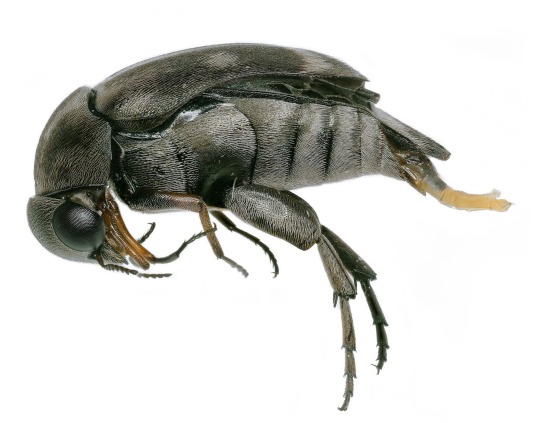
Ground Level: Tumbling flower beetles have a triangular body that helps them escape predators. Photograph By Brian Brown, Natural History Museum of Los Aangele County
The results of their analysis, published in Nature on February 2, point to a distinct and previously unexamined network of ecosystems in rainforest trees. More than 60 percent of the 857 species of flies collected, for example, were found above ground level. Many, if not most, likely are new species, Brown says.
Previous studies have compared insects on the ground with those in the canopy, but this is one of the first efforts to understand insect diversity at smaller vertical intervals.
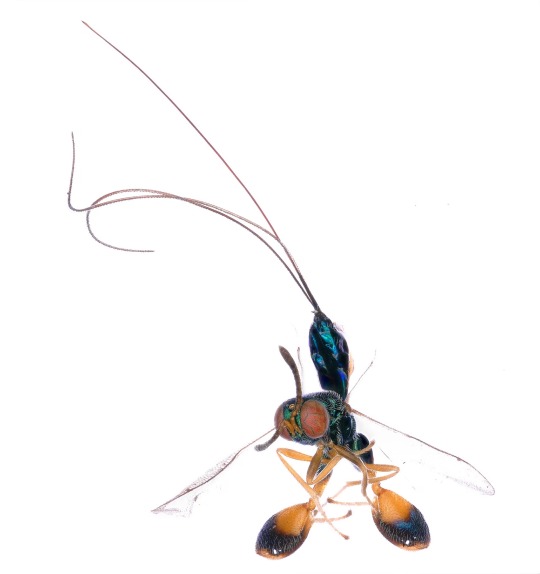
8 Meters (26 Feet): The mantis wasp uses its ovipositor—a needlelike organ for laying eggs—to pierce the egg cases of mantises. When the wasp’s larvae hatch, they feed on the mantis’s eggs. Photograph By Brian Brown, Natural History Museum of Los Aangele County
The findings underscore how much of the insect world still remains undiscovered, says Floyd Shockley, the collections manager of the entomology department at the Smithsonian Institution’s National Museum of Natural History, who was not involved in the study.
“Millions of things that live in the tropical canopy never come to ground,” he says, adding that these kinds of vertical studies “are incredibly important because [without them], we’re missing out on a tremendous amount of biodiversity.”
Sorting Insects
To collect the insects, Rafael set five large, tent-like netted traps off the tower at 26-foot intervals, starting at ground level and reaching up to 105 feet.
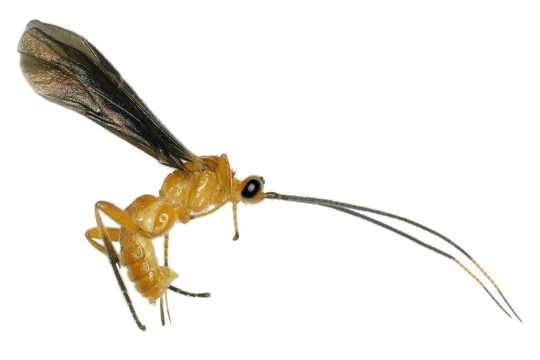
16 Meters (52 Feet): Both the forest canopy and the undergrowth are patrolled by parasitoid wasps seeking their prey—mostly caterpillars. Photograph By Brian Brown, Natural History Museum of Los Aangele County
Brown and Dalton de Souza Amorim, an entomologist at the University of Sao Paolo, and the rest of their team first sorted the insects by order (flies, beetles, bugs, and more). They focused on Diptera—flies—sorting more than 16,000 specimens into 56 families, then into 857 species. It’s unclear how many of those species are new to science. “It would take years and a ton of research to find out,” Brown says, but he guesses that many or most are undescribed.
Some families of flies were most abundant and diverse on the ground. Others were concentrated in the canopy. Still others peaked at the middle levels. Notably, between 90 and 100 percent of specimens of some families of flies were found in the four highest traps.

24 Meters (79 Feet): The watchful jewel beetle's massive eyes allow it to flee from predators—and researchers—quickly, making the beetles difficult to collect for study. Photograph By Brian Brown, Natural History Museum of Los Aangele County
What’s the Bigger Picture?
So much remains unknown about insects. “We’re still finding fish and amphibians, but we’re getting pretty close on birds and mammals to having a complete picture on their diversity,” Shockley says. But scientific models estimate the number of undiscovered insect species at between five and 30 million. “Every time we get one of these studies, it helps us improve the model so we can see how much we haven’t discovered.”
There are many reasons why knowledge of so many insect species remains elusive. “They’re small, they’re fast, they’re highly diverse, and they can occupy almost any niche,” he says.
So “we have to understand how they interact with each other, us, and crops,” Shockley says. “And we can’t talk about what they’re doing until we put a name on what they are.”

32 Meters (105 Feet): Iridescent orchid bees, tropical cousins of bumblebees and honeybees, are among the multitude of insects that entomologists have collected at the observation tower. Photograph By Brian Brown, Natural History Museum of Los Aangele County
Most insect sampling has been done based on latitude and longitude and sometimes altitude—up a mountain, for example, where habitats can change dramatically. But by collecting insects vertically in forest habitats, which is hard to do, Shockley says, “we’re adding an additional dimension to our understanding of diversity in three-dimensional space.”
Flies get a bad rap—it can be hard for people to understand why we should care about them. “But organisms [like insects] are arguably way more important than mammals or birds for the structure of the forest,” Brown says. “They’re important for pollination, energy, recycling, and more. What would happen if there were no insects feeding on decaying bodies? The ecosystem services they provide are so vital—but almost invisible.”
#The Insects 🐞 🕷️ 🐜#The National Geographic#Natasha Daly#Brian Brown | Entomology Curator | Natural History Museum | Los Angeles County.#Manaus | Brazil 🇧🇷#Rafael | Entomologist | Brazil’s 🇧🇷 National Institute of Amazonian Research
0 notes
Text



Ian Robert Knight




National Museum of the American Indian

151 notes
·
View notes
Text
little things about the haikyuu boys that I love
characters: oikawa, akaashi, tsukishima, bokuto, hinata, kageyama, iwaizumi, kuroo, tanaka
warning: timeskip spoilers!!!
⋆ ★ ⋆
oikawa tooru:
hums when he walks
hums or sings when doing ABSOLUTELY anything
skips when he walks
always posing for photos
always somehow blocks iwaizumi in photos
takes selfies and pictures of the sunset
stays up late to watch volleyball
takes his nephew to practices
when he found out he wasn't in monthly volleyball he laid on the ground and used a volleyball as a pillow
his mentions of his and iwaizumi's "unbreakable bond of trust"
his post timeskip current concern was: he is mistaken as a minor
when the crowd goes "OLE!!" when he serves
how he strategies and finds people's weaknesses
his "worthless pride"
how he carried out his dream and followed his idol to argentina
calls kageyama "tobio-chan"
most likely learned spanish to live in argentina
literally the most well-rounded character in the entire thing
HIS CHARACTER DEVEOPLEMET!!!
akaashi keiji:
fiddles with his fingers
constant analyzing and overthinking (he's so real)
only second-year who is a vice-captain
the smartest character (class 6!)
thick thighs
his witty humor
his patience with bokuto
is the captain of the team anxiety and depression (other members are yachi, asahi, and kiyru)
his eyes
very humble
his blunt personality
his ability to deal with bokuto in the most strategic way
he's so perfect...wow
tsukishima kei:
is popular with girls at school
works at a museum in timeskip
loves strawberry shortcake
fiddles with his fingers when he's nervous
his character development - from calling volleyball just a club and then finding his love for it then further pursuing it as a career
how sassy he is
standing with a hand on his hip
bokuto kouatro:
likes girls on the thicker side
his friendship with kuroo
is quite literally THICK
in timeskip, he doesn't know how to pay taxes
rewatches himself on tv
loves to show off
dropping down from being the top 3 aces to the top 5 was because of his simplemindedness and mood swings lol
his hair deflates when he's in emo mode
the name bokuto literally translates to horned owl
his long knee pads
his "disciple" hinata
BOKUTO BEAM!!
hinata shoyo:
timeskip; is considered one of the best receivers in Japan
his ability to make friends with anyone
when he talks for kageyama, knowing he's uncomfortable
his growth... his entire development wow
somehow creates a relationship with EVERY single setter he crosses paths with
ninja shoyo
his ability to flatter people
his homesickness in brazil... and then it went away when he saw oikawa
literally biked home UP A MOUNTAIN every day, wth
kageyama tobio:
literally the youngest first-year
he was 15 at the japan youth camp, turned 16 after that, and THEN went to nationals
takes care of his fingernails
has insane memory
prioritizes his nutrition
i firmly believe he learned everything from iwaizumi and oikawa
genuinely DISTURBED when atsumu called him a goody-two-shoes and I think that's so funny
is awkward with animals, cause he feels like they don't like him
literally been involved with volleyball since he was three
vice-captain when he's a third year
timeskip kageyama signs his name with a heart just like how suga said
verryyy respectful to his superiors
low key the heartthrob of karasuno but he's so oblivious
him embracing his title as the "king of the court"
iwaizumi hajime:
beats everyone in arm wrestles (massive biceps)
rolls his sleeves
loves godzilla
wears his school uniform messy
can play baseball
is a gemini
caught bugs as a kid
underrated king
definitely loyal and dependable
literally, the BEST friend to put your trust in! the way he slapped some sense into oikawa about how you always work as a team and never alone
is bad at taking pictures (mainly selfies) ---that one with ushijima...
was so proud when he showed oikawa the fish oikawa's named after
is NOT afraid to cry
the denial of his and oikawa's "unbreakable bond of trust"
kuroo testuro:
chemistry nerd
likes girls with long hair
likes the ocean
actually prefers dogs over cats
a genuinely kind person
his worry is he can't get rid of his bedhead - which happens because he sleeps on his stomach with two pillows pressing into his face
youngest of the third years on nekoma
his friendship with bokuto
his interactions with daichi
his support for tsuki and helping him grow into a great player
the way he stands always with his hand on his hip
he is INSANE at defense, not just blocking but digging too
how supportive he is of kenma and how he was the foundation for something kenma learned to love
i'm pretty sure it's canon that he lives with his grandma... so cute
TIMESKIPPPPPPP PLEASEE
tanaka ryuunosuke:
how supportive he is. LITERALLY A PILLAR OF SUPPORT GAH!!
canon - married kiyoko
his mental toughness
most underrated character ever oml
such a good upperclassman :)
hype man!!
overcomes his anxiety mid-game
his obsession and overall respect toward kiyoko
his relationship with noya
the beanie!!
him and asahi have played every single match with no rest
#haikyuu spoiler#haikyuu#haikyuu!!#akaashi keiji#oikawa tooru#hinata shoyo#tsukishima kei#kageyama tobio#kuroo tetsurou#tanaka ryuunosuke#bokuto koutarou#iwaizumi hajime#hq spoilers#hq#haikyuu headcanons#headcanon#canon
111 notes
·
View notes
Text
Brazil had its own equivalent of Spinosaurus, named Oxalaia quilombensis. (Oxalia from Oxalá, the orisha venerated by many Afro-Brazilians, and quilombensis for quilombo, the towns created by free slaves)

Unfortunately it's known by fragmentary jaw remains which were tragically lost in the 2018 fire of the National Museum of Rio de Janeiro. At 12-14 meters long (estimated) It would have been about the size of the African Spinosaurus and it lived a semi-aquatic lifestyle in marine and riverine conditions much like them.
This is the largest theropod discovered in Brazil, so far, and together with the Argentine Giganotosaurus and Mapusaurus (which were in fact, near contemporaries), cements South America as the land with the largest dinosaurs, carnivorous or not, ever to live.
61 notes
·
View notes
Text





Queen Mary’s Engagements in Oct 2024:
01/10: Opening of Parliament
02/10: Official Visit to Brazil - Boat Trip on the Amazon, Adolpho Ducke Forest Reserve and the Amazonian Museum MUSA
02/10: Official Visit to Brazil - Official Reception by the Governor of Amazonas
03/10: Official Visit to Brazil - National Research Institute for the Amazon Forest, Center for Bioeconomy, Lunch
04/10: Official Visit to Brazil - Official Meeting with President of Brazil
04/10: Official Visit to Brazil - Public School, Agricultural Research Institute
04/10: Official Visit to Brazil - Working Dinner with UNFPA at Danish Embassy
05/10: Official Visit to Brazil - Botanical Garden with UNEP
08/10: State Visit from Iceland - Day 1
08/10: State Visit from Iceland - Banquet
09/10: State Visit from Iceland - Day 2
09/10: State Visit from Iceland - Return Event
10/10: State Visit from Iceland - Official Farewell
10/10: Christmas Seal
10/10: 25th Anniversary of the American Chamber of Commerce in Denmark
11/10: 750th Anniversary of Holstebro City
21/10: Official Visit to Germany - Official Welcome at Schloss Bellevue, Reception at the Bundestag
21/10: Official Visit to Germany - Nordic Embassy Complex 25th Anniversary
21/10: Official Visit to Germany - Official Dinner
22/10: Official Visit to Germany - Official Welcome in Schleswig-Holstein, Sailing Tour, Energy Conference at GEOMAR, Danevirke, Flensborghus
37 notes
·
View notes
Text

(Image, as well as much of my information, from Carboniferous Giants and Mass Extinction by George R. McGhee Jr.)
Take a look at this tree. On a scale of 1 to 10, how weird do you think it is?
You quite possibly just gave it a 3 or a 4 or something. Sure, it's a little odd, but does look vaguely normal, right? A friend of mine guessed it was some sort of baobab when I showed him the image.
This is, in fact Lepidodendron, an ancient tree from the Carboniferous, and by modern tree standards it is absolutely bizarre. Its closest surviving relatives, quillworts and clubmosses, only grow to a height of a few centimetres, yet Lepidodendron were giants that shot up to 50 metres tall... Briefly, before dispersing their spores and completely dying off.
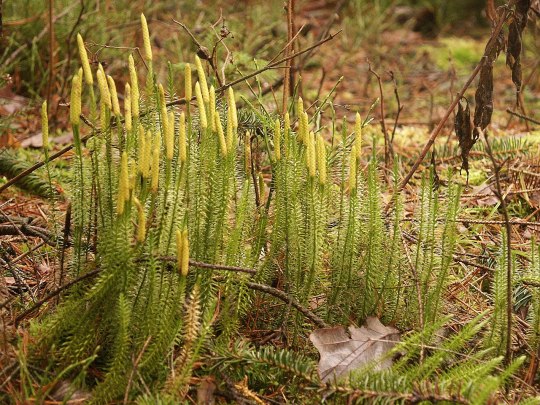

(Lycopodium and Spinulum, modern relatives of Lepidodendron, photos by Bernd Haynold and Pete Pattavina)
You see, Lepidondron lived like a gigantic dandelion. For most of its life, it was a stumpy little thing that stuck close to the ground. Just an odd scaly green stump with some long leaves poking out. The green scales its bark consisted of were the place it conducted its photosynthesis, and thus basically did the work of leaves. The Lepidodendron would stay like this for a couple years, slowly expanding its roots and getting ready for the next step. But its roots would grow mostly horizontally, down not so much! And part of why is that even they had the scaly leaf-like photosynthetic bark. That's right, even their roots could - and to some extend needed to - photosynthesise!

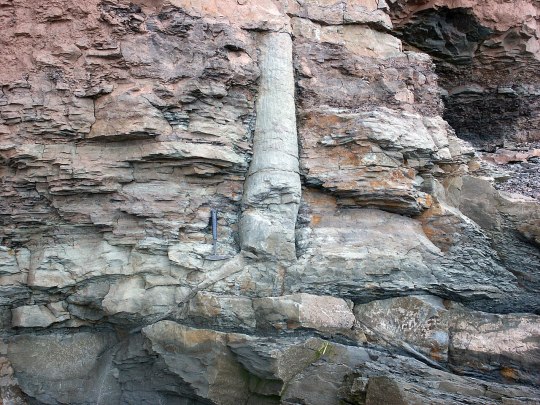
(Fossil Lepidodendron bark in the National Museum of Brazil, photo by Dornicke; a fossilised relative of Lepidodendron with some of its roots visible, photo by Michael C. Rygel)
So why would you ever try to photosynthesise with your roots of all things as a plant? Surely it would make much more sense to just transport the sugars created in other parts there than to have your roots be so shallow that bits of them can catch a little light and make it in situ? Sure, if you're capable of that! This is what modern trees do, but they have two separate vascular tissues they use for transport: xylem, which moves water from the roots to the rest of the plant, and phloem, which moves sugars and other photosynthetic products from the leaves to the rest of the plant. Unfortunately for Lepidodendron, it only had xylem, no phloem, so its sugars were only ever going to move as far as they could diffuse, so every part of the tree needed to have at least a little photosynthesis happening, even the roots.
This truly gets ridiculous when the Lepidodendron decides after a few years of charging up that it's time to reproduce. That's when the weird green stump we have so far starts shooting up, up, up, very quickly, all the way until an enormous 40 or 50 metres in height. Now, modern trees grow this large by being supported by a sturdy wooden core, but that's not what Lepidodendron did. To hold up the entire tree, it relies entirely on its outer bark thickening as it grows. In mechanical terms, it was little more than a huge hollow pole, probably creaking and swaying terribly in the wind. Although I have not been able to confirm this in the literature so far, I suspect that between the shallow roots and the whole thing being held up by its bark, you could probably total a Lepidodendron with a good kick.
Now remember, all this growth is happening without phloem, so the entire length of that stem has to not just be sturdy enough to keep the tree standing, but it also has to keep doing photosynthesis to feed itself. When it reaches its full height, the top of the tree finally starts sprouting branches and small leaves, leaving it looking like the picture at the start. But those are not what it's all about for the tree: the cones that develop among them are. At a height of 50 metres, the spores produced by the cones can very easily be picked up by the wind and blown far, far away. Being spores, rather than seeds as modern trees have, they have no supplies built in whatsoever, so they need to get lucky to land in a spot that has immediate access to water. Luckily, there are a lot of those in the vast Carboniferous swamps, and with the trees doing so much work to spread the spores very widely, some of them are sure to find good spots. And then, with the spores dispersed, the tree is done for. The entire thing, which has just grown to the skies, dies off and soon comes crashing down.

So how weird is this tree? I'd call it a perfect 10.
144 notes
·
View notes
Text
more repatriation news!
(9/13/24) A sacred cloak (c. 16th cent. CE) belonging to the Tupinambá people of Brazil was returned after more than 300 years in the collection of the National Museum of Denmark. The cloak contains more than 4,000 scarlet ibis feathers, and several other similar cloaks are still on display throughout Europe.

Tupinambá culture (modern Brazil); c. 16th century CE; 1.8m long
42 notes
·
View notes
Text

The Bendegó Meteorite in the National Museum, Rio de Janeiro, Brazil
Brazilian vintage postcard
#bendeg#sepia#rio de janeiro#photography#vintage#postkaart#museum#brazilian#meteorite#janeiro#ansichtskarte#ephemera#carte postale#postcard#postal#national#briefkaart#photo#the national museum#brazil#tarjeta#historic#postkarte
7 notes
·
View notes
Text


Gold coin minted in the rarely known Dutch colony of Brazil, 1646
from The National Museum of Denmark
279 notes
·
View notes
Text
Ncuti Gatwa’s Favourite?

Food spot in London: “I've just found a new one in Greenwich called Angle Ninety – it does high-style Nigerian food. The jollof bangs. The suya bangs. The lamb cutlets bang. It's just a little spot that does great food, and I think they do events there too. But also, honourable mention to Borough Market.”
Food spot in Scotland: “My mum's kitchen.”
Art gallery: “I like the National Portrait Gallery and I like the V&A.”
Museum: “The Natural History Museum. I need to go back there. I've only been there once and it was f****** amazing.”
International holiday destination: “Rio de Janeiro. I love Brazil and Rio is an incredible place.”
Staycation: “Maybe Devon? I like Devon and I like Cornwall. They're beautiful places: colourful houses; beautiful scenery. I just shot a film in Devon called The Roses and I definitely want to go back.”
Pamper spot: “I've got to give you three: 1) Ama Hair Salon, 2) for massages – OK now we're going boujee – The Corinthia, and 3) Omorovicza [The Spa at Liberty]. I like to pamper myself! We've all got to look after ourselves!”
Concert venue: “Principality Stadium in Cardiff – I went to see Beyoncé there twice. Other than that, I do like a night at Ronnie Scotts.”
Cinema: “There's one in Notting Hill where they've got like sofas and they've got a chandelier. That place is nuts. What's it called? That's it! Electric Cinema!”
Park: “Hilly Fields. And then head up to Blackheath.”
Any destination in the past: “Ancient Egypt.”
Any set in entertainment history: “Maybe The Matrix. To see all the pods.”
Year: “I would want to go 200 years into the future. I would want to see how we've done. I would want to see if we had sorted out climate change. I would want to see if we have sorted out all the world conflicts. And I would want to see if we've kept AI under control.”
Read More:
#ncutigatwa#15th doctor#doctor who#fifteenth doctor#the doctor#esquire#black tumblr#melanin#scottish#british actors#celebrity interviews#dw#lgbtqia#queer pride#london
21 notes
·
View notes
Text
Brazil’s National Museum launches first printed catalog of rare works

Brazil’s National Museum launched this week the first printed catalog of its collection of rare works. Although about 85% of the museum's 20,000 items were destroyed by a major fire occurred in September 2018, institution's director Alexander Kellner told Agência Brasil the rare works had been safely removed from the museum prior to the fire that consumed the Imperial Palace, located in Quinta da Boa Vista Municipal Park, in Rio de Janeiro.
«Fortunately, due to our policy of relocating collections from the São Cristóvão Palace, we were able to move our library,» said the director, adding that other collections were also safely stored off-site, Agência Brasil reports.
The Rare Works Catalog of the National Museum can be downloaded for free at https://pantheon.ufrj.br since its release on April 13, in addition to the printed version.
Continue reading.
15 notes
·
View notes
Text

Jan Nelson, Walking in tall grass, Shelby 2, 2011, oil on linen, 79 h cm, 56 w cm, National Gallery of Australia, Kamberri/Canberra, warwick and Jane Flecknoe Bequest Fund 2015 © Jan Nelson/Copyright Agency
Jan Nelson (born 1955) is an Australian artist who works in sculpture, photography and painting. She is best known for her hyper real images of adolescents. She has exhibited widely in Australia as well as Paris and Brazil. Her works are in the collections of Australian galleries, including the National Gallery of Australia, National Gallery of Victoria, Art Gallery of New South Wales, Museum of Contemporary Art, Sydney and the Gallery of Modern Art Brisbane, as well as major regional galleries. She represented Australia in the XXV biennale in São Paulo, Brazil.
24 notes
·
View notes